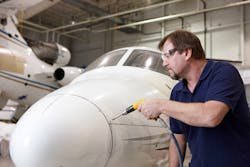Precision Tools for Precise Jobs
The driving force behind the 30-plus year long run of Pan American Tool Corporation’s Nova Pneumatic Tool product line is customer needs and requests.
“Feedback often drives the direction of the tooling due to their need to perform detailed tasks,” explained Phil Adams, Pan American Tool Corporation’s Nova Tool Specialist. “Updates are made regularly based on customer needs and requirements. Our customers can call us with specific design changes they would like to see in the tooling and, in most cases, we are able to achieve the changes they seek.”
Founded in 1986 to supply specialized metal cutting tools to the aviation and aerospace industries, Pan American Tool has continued to make advances and changes designed for tool improvement to this product line based on customer requirements.
The Nova tool line was imagined by Pan American Tool founder Bert Leon, who recognized the need for precision tooling in close quarter drilling applications and wanted to provide a high-quality tool at a reasonable price to the industry, as well as the mechanics who are tasked with purchasing the necessary tools for their specific requirements.
“Pan American Tool is constantly working with our customers to upgrade and improve the tooling per their application,” noted Adams. “We can design new tooling or redesign and existing tool, based on the needs of the customer and their specific applications.”
Benefits & Features
Key features of the Nova Pneumatic Tool product line include high-quality bearing and gear systems, as well as precision milling for proper motor and gear alignment. Pan American Tool offers a range of speeds and torque choices that are required when drilling a large variety of material types, such as titanium, aluminum and composites, to name a few.
Additional features consist of the ability to change out the drill head attachments that are designed to access unreachable areas that most tools would fail to achieve, says Adams. Other designs would include the ability to back drill and/or drill at specific angles such as a fixed 45 and 90 degree. The company also sells tooling accessories which allows for precision depth drilling that can be adjusted in .0001-inch increments, when tasked with such requirements.
Adams points out that changes in materials used in aviation and aircraft design are what drive tool technology and product trends. Composite material is now being used in a variety of applications in aircraft manufacturing. With these changes, come redesigning of tooling to meet those needs, such as solid carbide to cut and drill composites, as well as motor and gear design to accommodate the speed and torque for such rigorous tasks.
“Customer needs vary, but with the new materials that are taking over the industry, we are seeing the need for tooling that performs multi tasks in one application, such as our drill reamer combo,” said Adams. “Allowing the customer to drill and ream the hole to precision in one application, saving time from tooling change and money in tooling cost.”
Proper Care & Handling
Adams notes that some major factors in tool choice should always include knowing the materials you are working with and the proper speed and feed requirements based on the materials being used. Additionally, the user should understand the access and required angles that are consistent throughout the aviation industry, along with many other manufacturing applications.
“Proper care of lubrication and storage habits can lead to extended tool life,” he noted. “Over oiling is one of the biggest problems we see in the care and maintenance of pneumatic tools. Over oiling can inhibit the rotor vanes for retracting back into the rotor during use, causing the vane to sheer off and lock up the internals of the tool. This will lead to removal of the tooling from production applications and will require the tool to be sent out for repairs. Tools should be oiled sparingly for the first month or so and that oil should be inserted just prior to storage.”
The oil prevents moisture that has accumulated due to the compressed air from contacting the metal surfaces of the tool’s internals. Once the tool has been regularly oiled for a month, limited oil should be required, unless maintenance on that specific tool has been performed.
Pneumatic tool life can be extended with proper use of the tools for their designed applications. “Always use the correct tool for the job,” he offered. “We have made available to the industry many different styles and types of tooling for the rigors of close quarter drilling. Keeping up with current trends and proper tool applications will provide you with the best opportunity to achieve proper execution as well as safety, to tackle all your regular and irregular tasks,” Adams explained.
